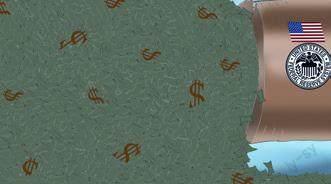The Dollar’s Downfall?
2022-05-30ByLiangXiao
By Liang Xiao
Seventy-five basis points. On September 21, the U.S. Federal Reserve (Fed) enacted its fifth—and likely not the last—rate hike of the year. Since the start of the rate hike cycle in March to tackle inflation, the Fed has raised its benchmark interest rate by 300 basis points, the most aggressive move since 1981.
At a press conference that same day, Jerome Powell, Chair of the Board of Governors of the Federal Reserve System, said the U.S. economy will experience a period of below-trend growth and the labor market will weaken due to continuous and substantial interest rate hikes. For the U.S., this is a side effect of treating the inflation crisis.
Since the onset of the COVID-19 pandemic, the U.S. had adopted an extra-loose monetary policy to stimulate economic recovery. Fed data on May 5 showed that at the start of 2020, about$4.02 trillion was in circulation, but by November 2021, that number had climbed to $20.354 trillion, meaning the U.S. had printed nearly 80 percent of all U.S. dollars in existence in under two years. But when the Fed increases the money supply faster than the economy is growing, inflation occurs.

Moreover, the money printed in the U.S. has to be digested by the world. The dollar is not only the currency of the U.S., but also the most important international currency. These printed banknotes flow to almost every corner of the globe for investment or consumption purposes. When the Fed raises interest rates, it means that the cost of U.S. dollar borrowing goes up, and investors will always choose to sell overseas assets at high levels and bring the gains back to the States.
Due to geopolitical tensions and the global energy crisis generated by the Russia-Ukraine conflict, international capital is increasingly attracted to a seemingly less affected U.S., sending the dollar soaring against virtually every foreign currency. The sharp shift in monetary policy produced by the Feds aggressive interest rate hikes has forced more countries to follow suit so as to maintain macroeconomic stability, which may in turn drag the global economy into a period of stagnation.
And so, the domination of the dollar faces new challenges.
No one is willing to be, as the Chinese would say, “picked like leeks” or played for a fool. The U.S.financial sanctions against Russia have also made more countries realize that under the dollar hegemony, if they are unilaterally sanctioned by the U.S., the dollar assets they hold will fail. A combination of avoiding over-reliance on the U.S. dollar and diversifying domestic foreign exchange reserves is swiftly becoming a preferred option for more and more central banks.
In fact, as the market share of the U.S. as a proportion of the worlds economy has steadily shrunk for two decades, the dollars dominance in the global financial system is constantly challenged.
According to a Society for Worldwide Interbank Financial Telecommunication report published in February, the U.S. dollar still ranks first among international settlement currencies, but it has dropped from 71 percent at its peak to 39.92 percent. An IMF Currency Composition of Official Foreign Exchange Reserves survey from June shows that the dollars share of global foreign exchange reserves fell below 59 percent—its lowest level in 26 years—during the fourth quarter of 2021. At the same time, other countries are also exploring the use of new clearing and settlement systems, such as the EUs Special Purpose Vehicle system and Chinas Cross-Border Interbank Payment System, and emphasizing the use of local currencies for settlement.
“The dollar is our currency, but its your problem.” These were the illustrious words John Connally, Treasury Secretary of the Richard Nixon administration, delivered to his astonished counterparts when the Group of 10, actually a group of 11 industrial countries that met on an annual basis to discuss economic, monetary and financial matters, convened in Rome in late 1971. For the next 50 years, the U.S. enjoyed the privilege brought by the dollar hegemony but was failing its responsibility of maintaining global economic growth.
For the U.S., the threat to its currency domination stems from its own backyard. If the U.S. continues to overdraft its credit, this will signal the prelude to the dollars downfall. BR
